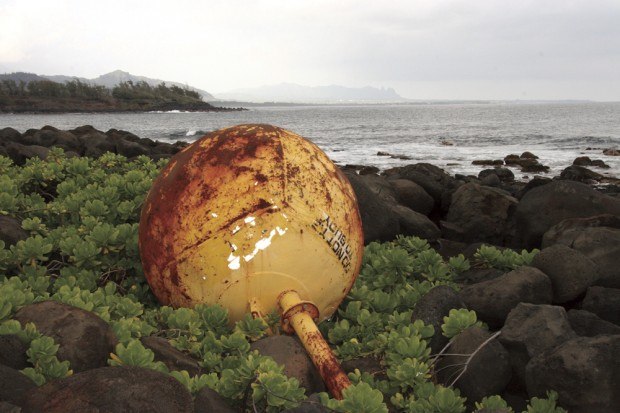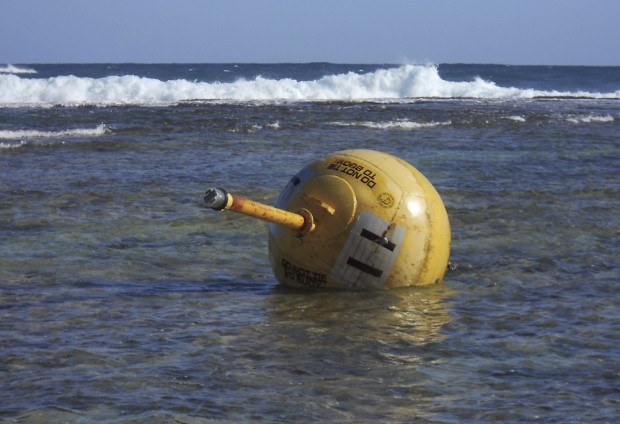LIHU‘E — For months, Moloa‘a resident Hope Kallai has been watching a large yellow buoy roll over the reef in front of Lepe‘uli Beach, also known as Larsen’s Beach, on the North Shore. “It took me a couple months to
LIHU‘E — For months, Moloa‘a resident Hope Kallai has been watching a large yellow buoy roll over the reef in front of Lepe‘uli Beach, also known as Larsen’s Beach, on the North Shore.
“It took me a couple months to find out who actually owns and sets these buoys,” said Kallai, concerned that the heavy metal buoy was killing the reef.
Such buoys that occasionally wash ashore on Kaua‘i are Fish Aggregating Devices, installed by the University of Hawai‘i Institute of Marine Biology and funded by the state Department of Land and Natural Resources Division of Aquatic Resources.
“They’re basically an anchored floating log,” said state marine fisheries biologist Don Heacock, explaining that fish tend to aggregate around floating things.
Over time, coral grows around the buoys, developing a mini-ecosystem that eventually attracts pelagic (deep water) fish, such as tuna, ono, mahi mahi, sharks and others.
Heacock said fishermen will probably find pelagic fish near a buoy, instead of “trolling all over the ocean.”
The buoys have their pros and cons.
“It doesn’t produce more fish, it just concentrates them,” Heacock said. “That’s the positive aspect. The negative aspect is that these things attracts a lot of juvenile tuna.”
A three-pound yellow fin tuna can easily fatten up to 30 pounds in only a few months, said Heacock, noting that some fishermen do not return those juvenile tuna to the ocean. Instead, they end up filling their coolers with tuna as little as one-to-three pounds.
Other fishermen, more “akamai,” release the juvenile fish back in the ocean, Heacock said.
The program, which has been running for almost 20 years, is funded by the DAR, which contracts out the UH IMB to do all the work.
“There are people that believe that this is really helping fishermen, and there are others that believe this program should be discontinued,” Heacock said.
The main reason why some are opposed to the program, besides the catch of juvenile fish, is that the buoys are not secured very well, according to Heacock.
“The weak link, pun intended, in this buoy system appears to be that they break loose,” Heacock said.
Currently on Kaua‘i there are at least four buoys known to have broken free from their anchor. Besides the buoy at Lepe‘uli, there is another resting on the rocks at Ahukini Landing, one above the shoreline at Donkey Beach, and one floating about a quarter-mile off Kealia Beach on the Eastside.
But not all of those buoys may be from Kaua‘i, Heacock said. O‘ahu has the same program, and a downstream current could bring O‘ahu’s loose buoys to Kaua‘i and even Ni‘ihau, as has happened in the past.
“A lot of marine debris we see on our beaches comes from the Pacific Northwest or from O‘ahu,” Heacock said.
Heacock said he usually takes washed up buoys to Nawiliwili and stows them until they can be recycled and redeployed in the ocean.
Program may need
to be revisited
The buoys may cost thousands of dollars to be deployed, and the question of cost-benefit lies in how many fish were caught around a buoy that has been washed ashore, Heacock said.
The commercial fishermen are required to put their catch on their report. Most fishermen, however, don’t understand how important it is to keep accurate records, Heacock said.
The buoy that washed over the reef at Lepe‘uli Beach may have been in the ocean for a short time. Heacock said the coral growing on it was only one inch high and one inch in diameter.
“I’ve seen some buoys that were three years old that had coral heads that were the size of basketballs,” said Heacock.
In the incident of the buoy that has washed onto the reef at Lepe‘uli Beach, Heacock said it looks like someone tied up a boat to the buoy’s chasing chain, which increases drag. “That may be why it broke loose.”
The buoys are anchored by three large cement blocks, which are shackled together. The blocks are connected to a single chain that goes up 100 feet. Another 100-foot chain drops from the bottom of the buoy and a rope connects both chains, Heacock said.
The buoys are expensive and difficult to deploy, said Heacock, adding that they are usually anchored in depths between 3,000 and 6,000 feet.
Despite the long time running and the known benefits for Kaua‘i fishermen, Heacock was unsure of the program’s future.
“It’s a new administration. It may be a program we need to go revisit. How much is this improving fishing?” Heacock said.
The buoy that recently washed up at Lepe‘uli Beach is no longer rolling on the reef. Heacock, with the help of another man, rolled the 600-pounder up the beach and chained it to a tree. He said it will stay there until he can get help loading it on the back of his truck to take it to Nawiliwili Harbor.
The UH IMB website, updated Nov. 18, shows Kaua‘i is supposed to have nine buoys in its waters, but two are missing, one on the Eastside and the other on the Westside.
Go to www.hawaii.edu/HIMB/FADS or www.hawaii.gov/dlnr/dar for more information.
• Léo Azambuja, staff writer, can be reached at 245-3681 (ext. 252) or lazambuja@kauaipubco.com.



